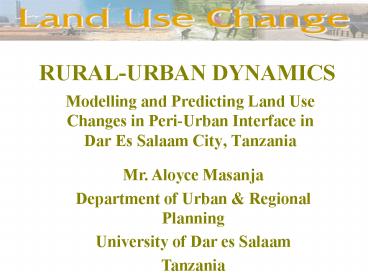RURALURBAN DYNAMICS PowerPoint PPT Presentation
1 / 14
Title: RURALURBAN DYNAMICS
1
RURAL-URBAN DYNAMICS
- Modelling and Predicting Land Use Changes in
Peri-Urban Interface in Dar Es Salaam City,
Tanzania
Mr. Aloyce Masanja Department of Urban Regional
Planning University of Dar es Salaam Tanzania
2
(No Transcript)
3
(No Transcript)
4
(No Transcript)
5
(No Transcript)
6
(No Transcript)
7
Conceptual Framework
8
RURAL URBAN DYNAMICSModelling and Predicting
Land Use Changes in the Peri-Urban Interface of
Dar es Salaam City in Tanzania
- The Project aim to model and explain the
interaction between socio-economics and
biophysical factors in the Peri-Urban interface. - It takes into account two major land uses that
are influenced by mankind agricultural and
urban land uses. - The model will simulate the changes of land use
in the interface - This project builds upon another study done by
Mwamfupe (1994), Masanja (1999) in an African
context and Lupala Masanja (2002). All the
studies confirmed high level of rural to urban
migration to the peri-urban interface,
socio-economic activities and agricultural land
transformation without guidance. - The studies confirmed the urban growth without
proper land use planning so poor infrastructure
and other basic services.
9
The Problem
- Urbanization, which is pushing agriculture to
less suitable land with unintended results. - The long term threat than agricultural land loss
is urban encroachment into fragile ecosystem
intensive land use with poor planning without
data. - Squatting is commonly found in watershed
catchments areas, protected lands and lands
subject to flooding or tidal inundations. - The city proper has been growing at the expense
of the peri-urban areas. - The impacts are two fold damage to the
environment and threat to health and well-being
of residents who live there (vulnerability).
10
The Objectives
- To identify the drivers of land use change in the
peri-urban interface. - To establish the links between human dimensions
and land use change - To develop databases on urban growth and land use
change drivers. - To develop models that depicting the existing
land use pattern and predict the future land use
change under different scenarios over time and
space. - To formulate policy implications and
recommendations for future land use planning and
management.
11
Approach and Design
- Both qualitative and Quantitative Approach.
- Use of Landsat Images in classification of land
use - Modelling land use by use multivariate regression
models, Focus Group Mapping, GIS model for
databases. - Use of Demproj model demographic change and
prediction - Participatory workshops for solution search
12
Outputs
- An improved understanding of land use change
drivers in the peri-urban environment. - A qualitative approach as a working methodology
for spatial structures indicating components of
vulnerability drivers of land use changes. - A GIS dadabases for planning and policy
formulations - A spatially explicit and dynamic models
explaining aspects of land use changes. - Maps indicating hot spot that indicates areas of
future land use changes
13
Contribution to the LUCC science
- The project contribute directly to the goals of
the LUCC science plan foci 1,2 3 - The project aim to model empirically the
relationship between socio-economic dynamics and
biophysical factors in the peri-urban interface. - The time series databases of satellite imagery
and GIS model will contribute significantly to
Focus 2 of LUCC science plan - Modelling land use change with demographic change
and migration will improve the understanding of
the relationship of Rural-Urban Dynamics.
14
Application of the Outputs Beyond the science
community
- Planners may use the dynamic data to evaluate
environmental impacts, to delineate urban growth,
boundaries or services, to develop land use
zoning plans and to gauge future land use change.
- The data can be utilized by hydrologists to
evaluate new water sources for future
urbanization and analyse water pollution and
problems common in urban areas. - The amount and degree of water pollution in
rivers, lakes and bays can be predicted in the
basis of past and future trends in land use
changes. - Geologists can use the data on land use change to
evaluate the availability of building materials
such as sand, gravel, and cement. They can use
the data to predict the impacts of future natural
disasters and the potential damage they may
cause. - Biologists can use the data of land use change to
compile maps on habitant species, distribution
and land management. Prediction about future
urbanization are critical to the protection of
ecosystem and sustainability of communities. - Policy makers can use the data to formulate
policies and interventions for future development
of the city.

